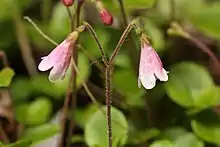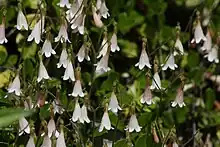| Linnaea borealis | |
|---|---|
 | |
| Linnaea borealis ssp. longiflora in flower, near the Matanuska Glacier in Alaska | |
| Scientific classification | |
| Kingdom: | Plantae |
| Clade: | Tracheophytes |
| Clade: | Angiosperms |
| Clade: | Eudicots |
| Clade: | Asterids |
| Order: | Dipsacales |
| Family: | Caprifoliaceae |
| Genus: | Linnaea |
| Species: | L. borealis |
| Binomial name | |
| Linnaea borealis | |
| Subspecies[2] | |
| Synonyms[2] | |
|
List
| |
Linnaea borealis is a species of flowering plant in the family Caprifoliaceae (the honeysuckle family). Until 2013, it was the only species in the genus Linnaea. It is a boreal to subarctic woodland subshrub, commonly known as twinflower (sometimes written twin flower).
This plant was a favourite of Carl Linnaeus, founder of the modern system of binomial nomenclature, after whom the genus was named.
Description
_leaf.jpg.webp)
The perennial stems of Linnaea borealis are slender, pubescent, and prostrate, growing to 20–40 centimetres (8–15+1⁄2 inches) long, with opposite evergreen rounded oval leaves 3–10 millimetres (1⁄8–3⁄8 in) long and 2–7 mm (1⁄16–1⁄4 in) broad. The flowering stems curve erect, to 4–8 cm (1+1⁄2–3+1⁄4 in) tall, and are leafless except at the base. The flowers are paired, pendulous, 7–12 mm (1⁄4–1⁄2 in) long, with a five-lobed, pale pink corolla.[3][4]
L. borealis is self-incompatible, requiring cross-pollination to produce viable seeds; since pollen dispersal is usually not far, individuals and clonal colonies can become reproductively isolated.[5] Regardless of seed production, Linnaea plants in a particular area often spread by stolons to form clonal patches of the same genotype.
Taxonomy
Linnaea borealis was first formally described by Carl Linnaeus in 1753 in Species Plantarum.[6] It was then the sole species in the genus Linnaea. The genus name had been used earlier by the Dutch botanist Jan Frederik Gronovius, and was given in honour of Linnaeus. Linnaeus adopted the name because Linnaea borealis was his favourite plant.[7]
Linnaea borealis is considered to be a single circumboreal species, with three generally recognized subspecies:
- Linnaea borealis subsp. borealis - Europe
- Linnaea borealis subsp. americana - North America (formerly classified as the species Linnaea americana)
- Linnaea borealis subsp. longiflora - Asia, and western North America (from Alaska to California)
The English name "twinflower" for Linnaea borealis refers to the plant's paired flowers.
Distribution and habitat


Linnaea borealis has a circumpolar distribution in moist subarctic, boreal, or cool temperate forests, extending further south at higher elevations in various mountains, in Europe south to the Alps, in Asia south to northern Japan, and in North America south to northern California and to Arizona and New Mexico in the west, and to West Virginia (and formerly Tennessee) in the Appalachian Mountains in the east.[8][9]
Clonal stands of Linnaea can be long-persisting, in some places remaining extant even if seed is not produced or if seedling germination or establishment does not occur.
The species was presumably common in areas south of its present range during times of Pleistocene ("Ice Age") glaciations, and its clone-forming perennial growth habit has allowed it to survive the subsequent millennia locally within this former range in various high-elevation or otherwise cool and moist habitats, including algific talus slopes with persisting underground periglacial ice.
Conservation
While the three subspecies of L. borealis are all considered widespread, abundant, and secure in their main, northern ranges, all three subspecies are of conservation concern near the subspecies' range edges or at more southerly, disjunct sites.
In Great Britain, L. borealis ssp. borealis is listed as "nationally scarce", growing mainly in open pine woodlands in Scotland and northernmost England. Foresters consider this plant to be an indicator species of ancient woodlands, often found in association with creeping lady's tresses. It is found in about 50 sites around the country, with most situated in the woods around the Cairngorms; the southernmost locations are four sites in Northumberland and one in County Durham. The sparseness of the sites is responsible for the continued decline of the plant in the country. In Scotland, 37% of L. borealis patches studied consisted of a single genotype, reproducing clonally vegetatively but not producing viable seed. This is a conservation concern because, without viable seed, the species may not be able to re-populate restored habitat, and may not be able to adapt to climate change by establishing new populations.[5]
In the United States, L. borealis ssp. americana is of conservation concern in several states along or near the southern edge of the species' range, including Arizona, Iowa, Massachusetts, North Dakota, Pennsylvania, and West Virginia, and was known historically but now considered extirpated or possibly so in Illinois, Indiana, New Jersey, Ohio, Rhode Island, and Tennessee.
In Canada, Linnaea borealis ssp. longiflora is considered of conservation significance in the Yukon Territory, along the eastern edge of its range, where ssp. americana is widespread and abundant.
Since many of the outlying southern sites for Linnaea borealis are in habitats that are at high elevations or otherwise in cooler microclimates than the surrounding general landscapes, ongoing and prospective climate change has become a significant concern for the conservation of this species in such places, such as Ice Mountain in West Virginia, a low-elevation algific talus slope with persisting buried ice.
In culture

Linnaeus took L. borealis as his own personal symbol when he was raised to the Swedish nobility in 1757. In his Critica Botanica (1737), Linnaeus had used Gronovius's name Linnaea as an example to advocate the use of commemorative personal names as botanical names:
it is commonly believed that the name of a plant which is derived from that of a botanist shows no connection between the two...[but]...Linnaea was named by the celebrated Gronovius and is a plant of Lapland, lowly, insignificant, disregarded, flowering but for a brief space — after Linnaeus who resembles it.[10][11]
The flower of Linnaea borealis is the provincial flower of Småland,[12] the home province of Linnaeus.
References
- ↑ NatureServe (2024). "Linnaea borealis". Arlington, Virginia. Retrieved 2024-01-12.
- 1 2 "Linnaea borealis L." Plants of the World Online. Royal Botanic Gardens, Kew. Retrieved 2024-01-12.
- ↑ Klinkenberg, Brian, ed. (2014). "Linnaea borealis". E-Flora BC: Electronic Atlas of the Plants of British Columbia [eflora.bc.ca]. Lab for Advanced Spatial Analysis, Department of Geography, University of British Columbia, Vancouver. Retrieved 2015-01-24.
- ↑ Giblin, David, ed. (2015). "Linnaea borealis". WTU Herbarium Image Collection. Burke Museum, University of Washington. Retrieved 2015-01-24.
- 1 2 Scobie, A. R.; Wilcock, C. C. (2009). "Limited mate availability decreases reproductive success of fragmented populations of Linnaea borealis, a rare, clonal self-incompatible plant". Annals of Botany. 103 (6): 835–846. doi:10.1093/aob/mcp007. PMC 2707897. PMID 19181748.
- ↑ "Linnaea borealis L." International Plant Names Index (IPNI). Royal Botanic Gardens, Kew; Harvard University Herbaria & Libraries; Australian National Botanic Gardens. Retrieved 2018-01-22.
- ↑ Christenhusz, Maarten J.M. (2013). "Twins are not alone: a recircumscription of Linnaea (Caprifoliaceae)". Phytotaxa. 125 (1): 25–32. doi:10.11646/phytotaxa.125.1.4.
- ↑ Sullivan, Steven. K. (2015). "Linnaea borealis". Wildflower Search. Retrieved 2015-01-24.
- ↑ USDA, NRCS (n.d.). "Linnaea borealis". The PLANTS Database (plants.usda.gov). Greensboro, North Carolina: National Plant Data Team. Retrieved 2015-01-24.
- ↑ Stafleu, Frans A. 1971. Linnaeus and the Linnaeans: the Spreading of their Ideas in Systematic Botany, 1735–1789. Utrecht: International Association for Plant Taxonomy. ISBN 90-6046-064-2. p. 83.
- ↑ Core, Earl L. (1975), The Wondrous Year: West Virginia Through the Seasons, Grantsville, West Virginia: Seneca Books, pg 45.
- ↑ Visit Småland Archived 2012-09-18 at archive.today Retrieved 25 February 2012.
- The Linnaeus Link Project in the spring 2005 edition of Nature First, the magazine for Natural History Museum members.
- Species and habitat conservation from Plantlife.org.uk and
- Twinflower species profile
External links
 Media related to Linnaea borealis at Wikimedia Commons
Media related to Linnaea borealis at Wikimedia Commons
